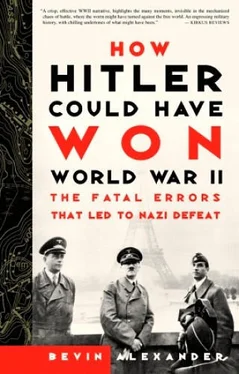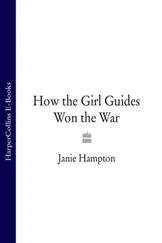The 4th Armored, supported by the 26th and 80th Infantry Divisions, collided with the German 5th Parachute Division on the main north-south road. The paratroops had to be driven out of every village and block of woods. However, reconnaissance found there was less opposition on the Neufchâteau-Bastogne road leading northeast, and on December 25 Patton shifted the main attack to this line.
In Bastogne the situation remained critical. Repeated German attacks forced the Americans back, but never overwhelmed them. When Lüttwitz sent a “white flag” party on December 22 calling on the garrison to surrender, General McAuliffe replied: “Nuts!” Subordinate officers, seeing the baffled looks on the Germans’ faces, translated it as “Go to hell!”
The next day better weather permitted Allied aircraft to drop supplies to the beleaguered troops. On Christmas Day the Germans made an all-out effort, but failed. Meanwhile the 4th Armored Division fought its way into the town at 4:45 P.M. on December 26. The siege was lifted.
A thin finger of Manteuffel’s advance got within four miles of the Meuse, five miles east of Dinant at Celles, on December 24. But that was the high-water mark. The British 30th Corps had moved onto the east bank of the Meuse around Givet and Dinant, and fresh American forces were coming up to help.
Hitler had recognized his hope of capturing Antwerp was an illusion, and had shifted his goal to seizing crossings of the Meuse, releasing the 9th Panzer and 15th Panzergrenadier Divisions from reserve to help Manteuffel clear the approaches to Dinant between Celles and Marche. But the panzers were being severely harassed from the air, and after December 26 none could move during the day.
Meanwhile Lawton Collins’s U.S. 7th Corps was converging on the threat. Collins had the 2nd and 3rd Armored Divisions and the 75th and 84th Infantry Divisions, and they slowly gained ground. On Christmas morning they recaptured Celles. The 9th Panzer Division arrived near the village on Christmas evening but could not shake the 2nd Armored Division in front of it.
Sepp Dietrich’s 6th Panzer Army to the north tried to assist Manteuffel, but his panzer divisions made little impression on American defenses that now were strongly reinforced, with swarms of fighter-bombers on momentary call to strike anything moving.
Manteuffel wrote that his reserves were at a standstill for lack of fuel just when they were needed.
Hitler wanted to hold the positions in the Bulge, and insisted that Manteuffel capture Bastogne by cutting Patton’s Neufchâteau-Bastogne corridor. But German attacks over three days, beginning December 30, failed.
It was obvious to Manteuffel that he could not hold the Bulge without Bastogne and could do nothing against Collins’s determined advance on the west. He telephoned Jodl and announced he was moving his forces out of the nose of the salient. But Hitler, as usual, forbade any step back. Instead, he ordered another attack on Bastogne.
To demonstrate how determined he was to have Bastogne, Hitler risked what was left of the Luftwaffe to prevent Allied fighter-bombers from intervening in Manteuffel’s efforts. Early on New Year’s Day a thousand Focke-Wulf 190 and Messerschmitt 109 fighters came in at rooftop level over twenty-seven Allied airfields in Holland, Belgium, and northeastern France. The Germans destroyed 156 planes, 36 of them American, most of them on the ground or while trying to take off. These were heavy losses, but the Allies could replace them quickly. The Luftwaffe, however, lost 300 planes and as many irreplaceable pilots, the German air force’s largest single-day loss in the war. It was the Luftwaffe’s death blow.
Having failed to cut the corridor south of Bastogne, Manteuffel now struck from the north astride the Houffalize-Bastogne road, using four depleted and exhausted divisions which, between them, had only fifty-five tanks. The Germans got nowhere, just as Manteuffel had feared. He now pulled the forces off. The threat to Bastogne ended.
At last on January 8, 1945, Hitler agreed to a limited withdrawal from the tip of the Bulge. Inexorably, the retreat continued. By January 28, the German lines were back approximately where they had been when the offensive started.
Among 600,000 Americans eventually involved in the battle of the Bulge, casualties totaled 81,000, of whom 15,000 were captured and 19,000 killed. Among 55,000 British involved, casualties totaled 1,440, of whom 200 were killed. The Germans, employing close to 500,000 men, lost at least 100,000 killed, wounded, or captured. Each side forfeited about 800 tanks, and the Luftwaffe lost a thousand aircraft.
The Americans could make good their losses in short order, the Germans could not replace theirs. All that Adolf Hitler achieved at this terrible cost was to delay the Allied advance in the west by a few weeks. But it actually assured swift success for the Red Army advancing in a renewed drive in the east. In the end, the battle of the Bulge probably speeded up Germany’s collapse.
24 THE LAST DAYS

THE RED ARMY HAD BEEN STALLED ALONG THE VISTULA RIVER IN POLAND SINCE autumn 1944. Its astonishing advances during the summer had come to a standstill because the vastly overextended Russian supply line finally snapped. Red Army commanders held up the final assault on Nazi Germany until the railways behind the front could be repaired and converted to the Russian wider-gauge track.
Once done, the Soviets accumulated abundant supplies along the entire front and reconstituted their armies. By early 1945 they had assembled 225 infantry divisions and twenty-two armored corps between the Baltic Sea and the Carpathian Mountains. Soviet superiority was eleven to one in infantry, seven to one in tanks, and twenty to one in artillery and aircraft. Most important was the great quantity of American trucks delivered to the Russians by Lend-Lease. Trucks transformed a large part of the Red Army into motorized divisions able to move quickly around the Germans, whose mobility was shrinking by the day due to extreme shortages of fuel.
When Heinz Guderian, army chief of staff, presented the figures of Soviet strength, Hitler exclaimed, “It’s the greatest imposture since Genghis Khan! Who is responsible for producing all this rubbish?”
Hitler had not used the long stalemate in the east to build a powerful defensive line of minefields and antitank traps—such as Erwin Rommel had urged immediately after the battle of Kursk in 1943. His defensive system remained what it had been all along: each soldier was to stand in place and fight to the last round. He refused even a timely step back to avoid the full shock of a Soviet attack. The Russians were well aware of the hopeless weakness of Hitler’s “hold-at-all-costs” policy, and were prepared to exploit it.
On December 24, 1944, Guderian met with Hitler and his staff and pleaded with them to abandon the Ardennes offensive and move every possible soldier eastward to shield against the Soviet attack.
The heart of continued German resistance, Guderian emphasized, was the industrial region of upper Silesia (about fifty miles west of Cracow around Katowice and Gliwice). The German armaments industry had already been moved there, and it was beyond the range of American and British bombers. The Ruhr, on the other hand, was paralyzed by bombing attacks.
“The loss of upper Silesia must lead to our defeat within a very few weeks,” Guderian said.
It was no use. Hitler insisted that continued attacks in the west would eventually cripple the western Allies. Furthermore, he rejected Guderian’s request to evacuate by sea the army group (of twenty-six divisions) now isolated in Courland in western Latvia. And while Guderian was en route back to his headquarters near Berlin, Hitler transferred two SS panzer divisions from the Vistula to Hungary with the task of relieving the siege of Budapest. This left Guderian with a mobile reserve of just twelve divisions to back up fifty weak infantry divisions holding a front 750 miles long.
Читать дальше



![Джонатан Димблби - Barbarossa - How Hitler Lost the War [calibre]](/books/385421/dzhonatan-dimblbi-barbarossa-how-hitler-lost-the-w-thumb.webp)









